Insulin Implant Controls Blood Glucose Levels — Spares Diabetics Injections And Big Spending

Insulin injections — the bane of many diabetics. Having to endure two injections of insulin per day can be a painful and expensive nuisance. However, the standard treatment might be long gone as Joan Taylor, British scientist from De Montfort University in Leicester, has started developing a new implantable insulin device that could potentially save a substantial amount of money for patients. It works like an artificial pancreas and is about the size of a watch, the Daily Mail reported.
“This device is cheap and simple to use,” Taylor told the Daily Mail. “It has the potential to bring an end to the misery of daily injections for diabetics.” The American Diabetes Association estimates the cost of diagnosed diabetes in 2012 was $245 billion, and according to Taylor, much of that cost is due to mistakes. By implanting the device, patients will be administered the exact dosage — mistake-free. The implant will have a supply of insulin that will be kept in place by a gel barrier; as the glucose levels in the body rise, the implant will release the insulin. In essence, the device will mimic a normal-functioning pancreas. When the glucose levels fall back to the normal range, the gel will harden up again. This can be replenished every two weeks by a tube which passes through the skin.
It could also revolutionize the way people manage diabetes as the device will almost act as a pseudo-cure saying goodbye to injections forever. Not only will this save time and pain; it will also save a lot of money. When converted to American dollars, the device and surgery will cost approximately $8,241. Of course, this is an abstract figure and the finer details of the device and surgery would need to be sorted out. While this might seem costly, considering how much people spend annually on diabetes maintenance might make the price not seem so bad.
“After 20 years of research, we are hopeful we have found a solution which has the potential to bring an end to the misery of daily injections for diabetics across the world within the next 10 years,” said Taylor, the Daily Express reported.
Human trials for the device should begin in 2016. Taylor hopes that this will change the lives of many people suffering from both type 1 and type 2 diabetes. “I believe it should be globally available, not just here but in some of the poorest countries,” Taylor said.
Published by Medicaldaily.com



























